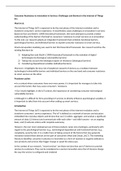Samenvatting
Samenvatting Mani et al. (2018): Consumer resistance to innovation in services: challenges and barriers in the Internet of Things era
Ontbreekt in vrijwel alle samenvattingen. Uitgebreide de belangrijkste zaken in het artikel weergegeven,
[Meer zien]




